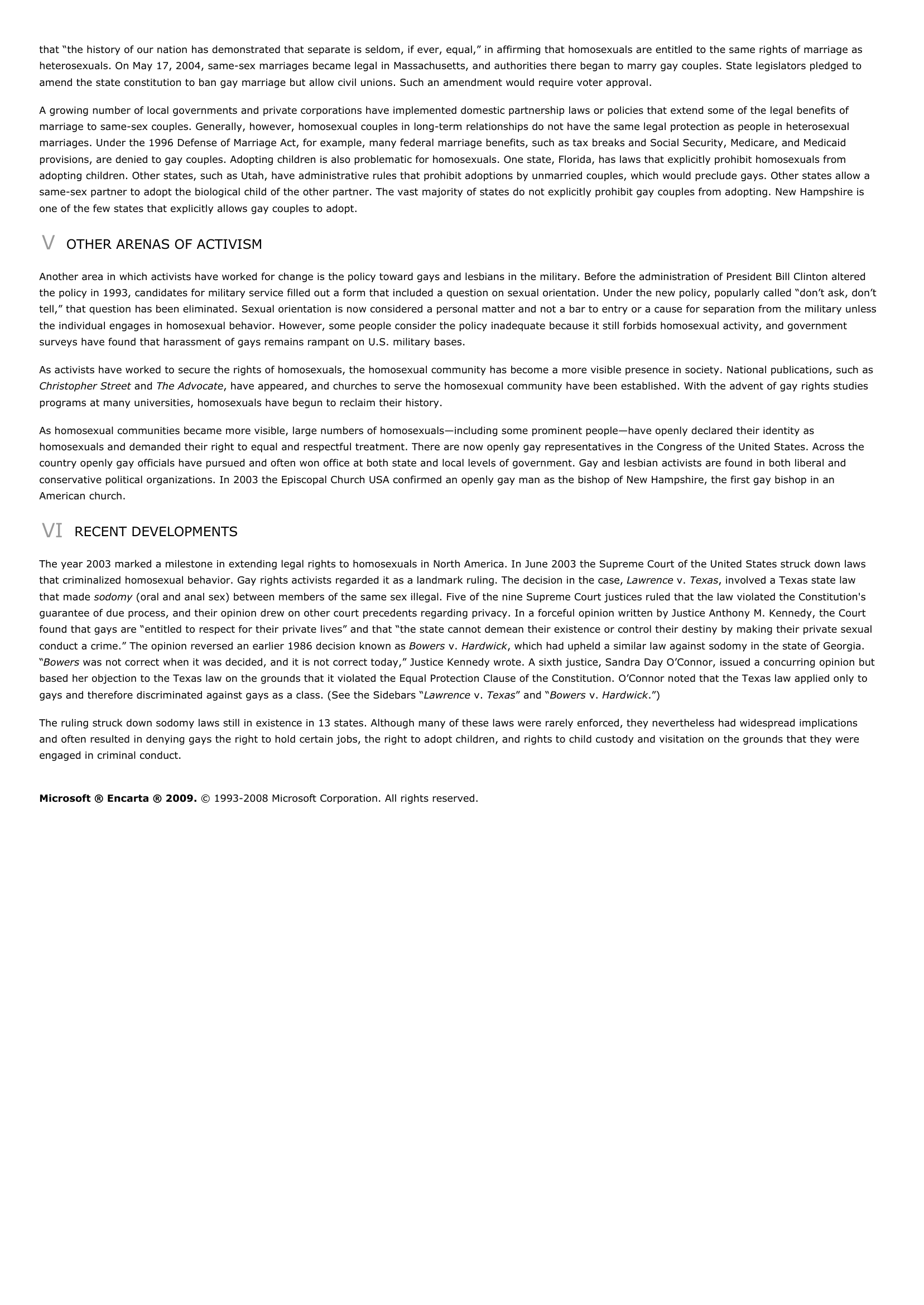Homosexuality.
Publié le 10/05/2013

Extrait du document
«
that “the history of our nation has demonstrated that separate is seldom, if ever, equal,” in affirming that homosexuals are entitled to the same rights of marriage asheterosexuals.
On May 17, 2004, same-sex marriages became legal in Massachusetts, and authorities there began to marry gay couples.
State legislators pledged toamend the state constitution to ban gay marriage but allow civil unions.
Such an amendment would require voter approval.
A growing number of local governments and private corporations have implemented domestic partnership laws or policies that extend some of the legal benefits ofmarriage to same-sex couples.
Generally, however, homosexual couples in long-term relationships do not have the same legal protection as people in heterosexualmarriages.
Under the 1996 Defense of Marriage Act, for example, many federal marriage benefits, such as tax breaks and Social Security, Medicare, and Medicaidprovisions, are denied to gay couples.
Adopting children is also problematic for homosexuals.
One state, Florida, has laws that explicitly prohibit homosexuals fromadopting children.
Other states, such as Utah, have administrative rules that prohibit adoptions by unmarried couples, which would preclude gays.
Other states allow asame-sex partner to adopt the biological child of the other partner.
The vast majority of states do not explicitly prohibit gay couples from adopting.
New Hampshire isone of the few states that explicitly allows gay couples to adopt.
V OTHER ARENAS OF ACTIVISM
Another area in which activists have worked for change is the policy toward gays and lesbians in the military.
Before the administration of President Bill Clinton alteredthe policy in 1993, candidates for military service filled out a form that included a question on sexual orientation.
Under the new policy, popularly called “don’t ask, don’ttell,” that question has been eliminated.
Sexual orientation is now considered a personal matter and not a bar to entry or a cause for separation from the military unlessthe individual engages in homosexual behavior.
However, some people consider the policy inadequate because it still forbids homosexual activity, and governmentsurveys have found that harassment of gays remains rampant on U.S.
military bases.
As activists have worked to secure the rights of homosexuals, the homosexual community has become a more visible presence in society.
National publications, such asChristopher Street and The Advocate , have appeared, and churches to serve the homosexual community have been established.
With the advent of gay rights studies programs at many universities, homosexuals have begun to reclaim their history.
As homosexual communities became more visible, large numbers of homosexuals—including some prominent people—have openly declared their identity ashomosexuals and demanded their right to equal and respectful treatment.
There are now openly gay representatives in the Congress of the United States.
Across thecountry openly gay officials have pursued and often won office at both state and local levels of government.
Gay and lesbian activists are found in both liberal andconservative political organizations.
In 2003 the Episcopal Church USA confirmed an openly gay man as the bishop of New Hampshire, the first gay bishop in anAmerican church.
VI RECENT DEVELOPMENTS
The year 2003 marked a milestone in extending legal rights to homosexuals in North America.
In June 2003 the Supreme Court of the United States struck down lawsthat criminalized homosexual behavior.
Gay rights activists regarded it as a landmark ruling.
The decision in the case, Lawrence v.
Texas , involved a Texas state law that made sodomy (oral and anal sex) between members of the same sex illegal.
Five of the nine Supreme Court justices ruled that the law violated the Constitution's guarantee of due process, and their opinion drew on other court precedents regarding privacy.
In a forceful opinion written by Justice Anthony M.
Kennedy, the Courtfound that gays are “entitled to respect for their private lives” and that “the state cannot demean their existence or control their destiny by making their private sexualconduct a crime.” The opinion reversed an earlier 1986 decision known as Bowers v.
Hardwick , which had upheld a similar law against sodomy in the state of Georgia. “Bowers was not correct when it was decided, and it is not correct today,” Justice Kennedy wrote.
A sixth justice, Sandra Day O’Connor, issued a concurring opinion but based her objection to the Texas law on the grounds that it violated the Equal Protection Clause of the Constitution.
O’Connor noted that the Texas law applied only togays and therefore discriminated against gays as a class.
(See the Sidebars “ Lawrence v.
Texas ” and “ Bowers v.
Hardwick .”)
The ruling struck down sodomy laws still in existence in 13 states.
Although many of these laws were rarely enforced, they nevertheless had widespread implicationsand often resulted in denying gays the right to hold certain jobs, the right to adopt children, and rights to child custody and visitation on the grounds that they wereengaged in criminal conduct.
Microsoft ® Encarta ® 2009. © 1993-2008 Microsoft Corporation.
All rights reserved..
»
↓↓↓ APERÇU DU DOCUMENT ↓↓↓










